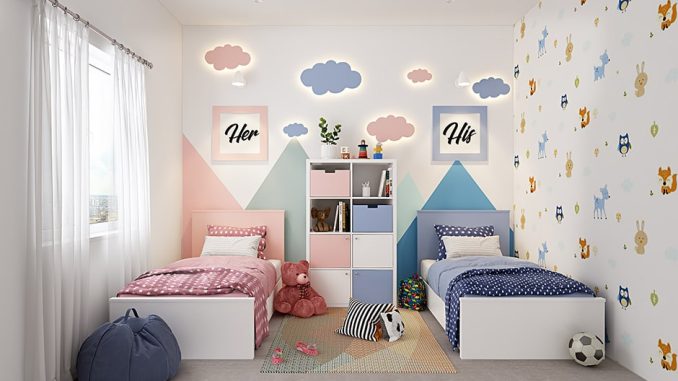
Children’s rooms are typically furnished according to different rules than regular furniture design. The emphasis is on functionality and safety, and aesthetics are ignored, at least for the first three years of the child’s life. Furniture and furnishings in this room will be replaced at least three or four times before your child becomes an adult, so think short-term when planning the furniture for your child’s room.
In short, creating a nursery means creating a room that is comfortable, safe, equipped with baby furniture, and organized. This is because your child will spend a lot of time in this space in the early years of his or her life, and you want to keep everything within easy reach.
Here are some basic steps to properly prepare the room for your new family member!
1) Prepare the Walls
It is preferable to apply non-toxic paint or paste wallpaper to the walls of the children’s room, but if you are going to paint the walls, do it at least two months before the new occupants arrive. This will allow enough time for the paint odor to dissipate. If you choose wallpaper or wall stickers, make sure they are non-toxic materials.
The basic colors are white and cream, but pastel colors are also perfect. Children will be interested in brightly colored stickers on nearby walls, such as funny owls or sleeping monkeys.
2) Prepare the Window
As for windows, make sure the room is dark enough for children to sleep in and that natural light is available during the day without problems.
Brightly colored sheer curtains or translucent or opaque curtains with cute prints such as animals, birds, or cartoon characters should be used. Also, choose curtains or short drapes so your child cannot reach and pull them down when he or she begins to explore the room.
3) Floor Preparation
Even in rooms with heated floors, carpeting is essential, especially in children’s rooms where they are just beginning to walk. If the floor is hard, there is a risk of falling, so make sure there is a safe space for the child to move freely.
Choose an anti-bacterial carpet with a non-slip layer and a short pile that is easy to clean. Colorful designs with cheerful animal patterns are more suitable than colorful ones with geometric patterns or abstract prints.
4) Select a Bed
Children’s beds should be safe, comfortable, and durable.
- The distance between the sides of the bed should not exceed 3-4 cm.
- The height can be adjusted.
- Folding bed models are equipped with a protection system that prevents accidental closure.
- The mattress is hypoallergenic, firm, conforms to allow the skin to breathe, and fits snugly against the bed frame.
- If the bed has a canopy, it should not be covered by an arch. Don’t forget to check the suspension regularly.
/shutterstock_572412316-661b93f66ee0489abe91d42cb5c58659.jpg)
5) Selecting Linens for Children’s Beds
Suitable bed linens for children’s beds are those made of natural fibers (cotton, reinforced cotton, cotton poplin).
Bed linens must be stretchable, or they will not stay in place properly.
Printing inks should be safe and non-toxic.
6) Selecting the Right Furniture for a Nursery
In addition to a bed and nursing chair, you should have a large enough wardrobe to hold all of your clothes, blankets, bed linens, accessories, bags, a folding mat for changing diapers, care items, and other necessary items for life with a baby. Choose a larger model, but one that can be used after your baby is older.
Cabinets can be placed out of harm’s way for the baby or against a wall.
Let us know if these few tips have helped in the comments below!

Leave a Reply